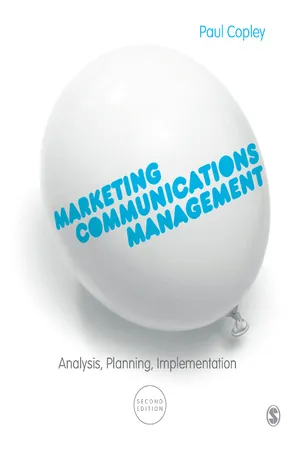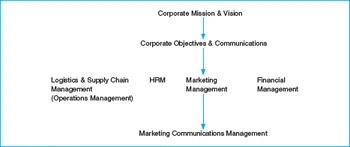Marketing Communications’ Place Within Strategic Marketing
The basic marketing concept is the managerial philosophy that seeks to identify and satisfy customer needs and wants better than the competition through a series of coordinated marketing activities to achieve organisational objectives. The marketing concept suggests the useful shorthand that is the ‘marketing mix’ (or ‘4Ps’ that are product, place, price and promotion). This has been and still is the subject of some debate in academic marketing circles. Building on the problem with mnemonics, Kent (1986), for example, underscores the ‘seductive sense of simplicity’, the point being that to create something that is a memory aid that then becomes an ‘article of faith’ is dangerous. The 4P ‘model’ has been interpreted by some as a strategic tool, but for others it is merely a convenient piece of shorthand. Inevitably, issues around product, price, place and promotion will be considered as being at the heart of marketing strategy. However, the 4Ps is a model from the mass marketing era. Given the emphasis now placed on interactivity, engagement and relationships, marketing strategy and hence marketing communications strategy have to be more than a consideration of the 4Ps. It is with this kind of understandable argument in mind that the useful shorthand is adopted here with caution and qualification.
Marketing communications can be described as being every form of communication relevant to marketing. This invites marketing communications managers to question the efficiency of every item of communication as it relates to and affects the whole strategy. The basic promotional mix elements and their derivatives as the requirements for effective communications and customer understanding have been recognised for some time as being ‘above-the-line’ advertising and ‘below-the-line’ everything else including the main categories of sales promotion, public relations and personal selling. The line is an artificial construct devised for accounting purposes within the commission system where 15 per cent of billing was the fee in advertising terms for placing the message in the appropriate space and the difference between what the agency paid and what the client paid. There has always been a fee-per-job or service base for much of what agencies did for clients, i.e. fee-based transactions. The percentage rate paid by the media to agencies has never been truly universal. The 15 per cent rate was a US import into the UK for example, as more and more advertising was being conducted by US agencies as advertising evolved during the 20th century (see Chapter 5 of this book for more on the move away from this system). More broadly it is not unusual to see the term ‘through-the-line’ being used to indicate changes that have taken place in recent times across the marketing communications mix (see Integrated Marketing Communications later in this chapter). Figure 1.1 below shows the relationships between corporate and marketing communication functions and other business functions.
With audiences having become more fragmented, mass communication is rapidly becoming a relic of a former era. It is now recognised in many markets that there is a need for media and media vehicles that match this fragmentation. Mass communication was, traditionally, relatively low cost but had the disadvantages of involving selective perception and poor comprehension of the message. There was also the possibility of a monologue taking place with little or no feedback received and with the added difficulty of measuring effectiveness. Personal communication, on the other hand, has been seen as approximately the opposite of this with high cost per contact at a slower speed but with the opportunity to better get the message across. There is therefore much higher comprehension of the message and the possibility of a dialogue with fast and accurate feedback and consequently a move toward ‘narrowcasting’, i.e. taking a programme or a message to a narrower but more relevant audience, rather than ‘broadcasting’ to a wider set of audiences. The promotion ‘p’ of the traditional marketing mix has become known as marketing communications in part because the term communications better describes the nature of this element of marketing activity. It is not always the goal of the organisation to promote a product, service or the organisation itself. The goal, for example, could very well be to educate or inform. Another issue is that of confusion with the range of marketing tools that are known as ‘sales promotions’, which have a specific, definable nature (see Chapter 11 of this book on the nature of sales promotion). Added to this is the fact that many things communicate: for example, legible telephone numbers on letterheads; brand name for display on packs; product/brand/corporate image; price; shape/design of container for recognition on television; shelves and colour of product/pack; and even easy-to-follow instructions. The use of a combination of such devices leads, it is argued, to customer/consumer understanding and better positioning of the company/brand. Jensen (2007) highlights the impact of the Internet and the inevitable inclusion of online activities in the marketing communications mix. Such activities include, for example, email and social networks (see Chapter 10 of this book).
Figure 1.1 Corporate and marketing communications functions and other business functions relationships
The basic marketing mix, therefore, usually includes communication as a fundamental element (labelled promotion) but the communication itself is a mix of elements. The old promotions mix was usually seen as consisting of the four basic elements of advertising, sales promotion, marketing public relations and personal selling. It is now recognised that this is forever developing and mutating. Corporate public relations might be separated from marketing public relations but both can be seen as elements of the communications mix that might be used in the development of a corporate image and identity. Sponsorship, for a long time seen as part of public relations, is now considered as a marketing and sometimes corporate communications element in its own right. The optimal mix is determined by factors such as the nature of the context, degree of control available, cost, credibility, and size or geographic spread of target audiences. A generalised expression of the communications mix is visualised in Figure 1.2 below.
Figure 1.2 The communications mix
Each element of the mix has characteristics that help the marketer make decisions as to its usefulness or appropriateness in any given context. This can be represented, using just a few examples, in the following way.
Figure 1.3 illustrates that generally speaking advertising is more appropriate to a consumer communications mix than to an organisational/industrial/B-to-B communications mix. The reverse is the case with personal selling. With Public Relations this can be represented with a horizontal line to suggest the recommended constant employment of this element regardless of the context. Exhibitions and trade shows may be more common in organisational contexts, such as the International Materials Handling Exhibition, usually held at the National Exhibition Centre, Birmingham, UK. Of course these do exist in consumer contexts such as the Ideal Home Show, usually held at Earl's Court London, which is both consumer and trade.
The marketing communications elements can be viewed through a control versus spend lens, i.e. some elements such as advertising offer more control over what, when, how, who to, and where communications takes place. If financial resources are abundant then it is up to the organisation how much it will spend on, for example, buying media space or employing celebrity endorsement. On the other hand, public relations, but especially media relations, are much less of a controllable item. Decisions are in the hands of those who control the media (or media vehicles such as a particular magazine, where the controller is usually an editor of some denomination, for example the food and drink editor of a newspaper). The marketer can take certain action such...


